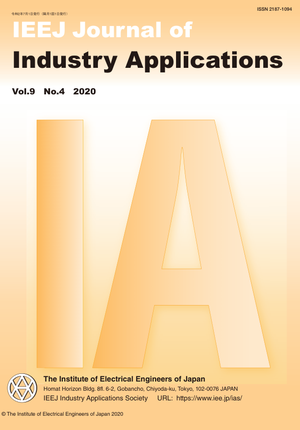PV MPPT Control under Partial Shading Conditions with a Particle Replacement Gaussian Particle Swarm Optimization Method
PV MPPT Control under Partial Shading Conditions with a Particle Replacement Gaussian Particle Swarm Optimization Method
カテゴリ: 論文誌(論文単位)
グループ名: 【D】産業応用部門(英文)
発行日: 2020/07/01
タイトル(英語): PV MPPT Control under Partial Shading Conditions with a Particle Replacement Gaussian Particle Swarm Optimization Method
著者名: Bingcheng Ji (Department of Advanced Energy, Graduate School of Frontier Sciences, University of Tokyo), Katsuhiro Hata (Department of Informatics and Electronics, Institute of Industrial Science, University of Tokyo), Takehiro Imura (Department of Electr
著者名(英語): Bingcheng Ji (Department of Advanced Energy, Graduate School of Frontier Sciences, University of Tokyo), Katsuhiro Hata (Department of Informatics and Electronics, Institute of Industrial Science, University of Tokyo), Takehiro Imura (Department of Electrical Engineering, Tokyo University of Science), Yoichi Hori (Department of Advanced Energy, Graduate School of Frontier Sciences, University of Tokyo), Shuhei Shimada (Reseach Unit I, R&D Directorate, Japan Aerospace Exploration Agency), Osamu Kawasaki (Reseach Unit I, R&D Directorate, Japan Aerospace Exploration Agency)
キーワード: Gaussian particle swarm optimization,global maximum power point tracking,partial shading conditions,particle replacement,photovoltaic,simulated annealing
要約(英語): As a complementary renewable power source, the photovoltaics (PV) has played an increasingly important role in various applications. However, although the PV has been considerably developed in the past decades, the global maximum power point tracking (MPPT) under partial shading conditions still needs to be focused on. In this paper, a novel simulated annealing and particle replacement assisted Gaussian particle swarm optimization algorithm (GPSO) has been proposed. The proposed algorithm has been divided into two stages. In the first stage, the particles are replaced with Gaussian distribution at each iteration to reduce the particle distribution range, and when the distribution range is sufficiently narrow, this stage is completed. In the second stage, the GPSO update was used to track the global maximum power point for the generated particles from the reduced distribution range. The proposed algorithm has been verified with simulation and experiments. Compared with the conventional particle swarm optimization algorithm, the proposed method exhibited considerate improvement for both MPPT time and PV output power stability.
本誌: IEEJ Journal of Industry Applications Vol.9 No.4 (2020)
本誌掲載ページ: 418-427 p
原稿種別: 論文/英語
電子版へのリンク: https://www.jstage.jst.go.jp/article/ieejjia/9/4/9_418/_article/-char/ja/
受取状況を読み込めませんでした


